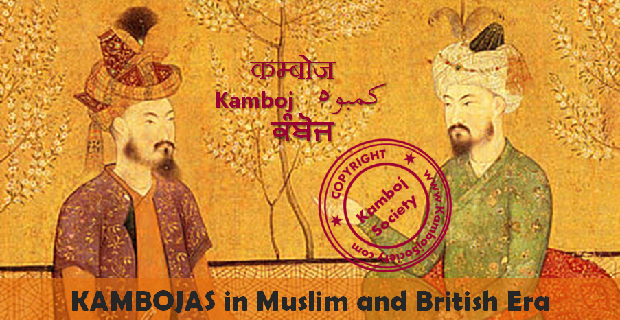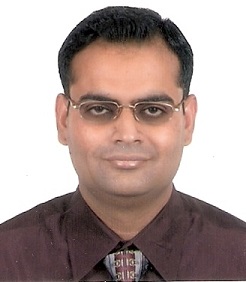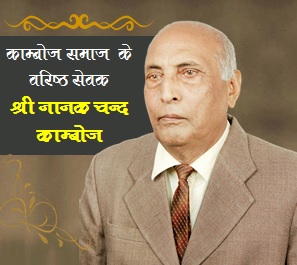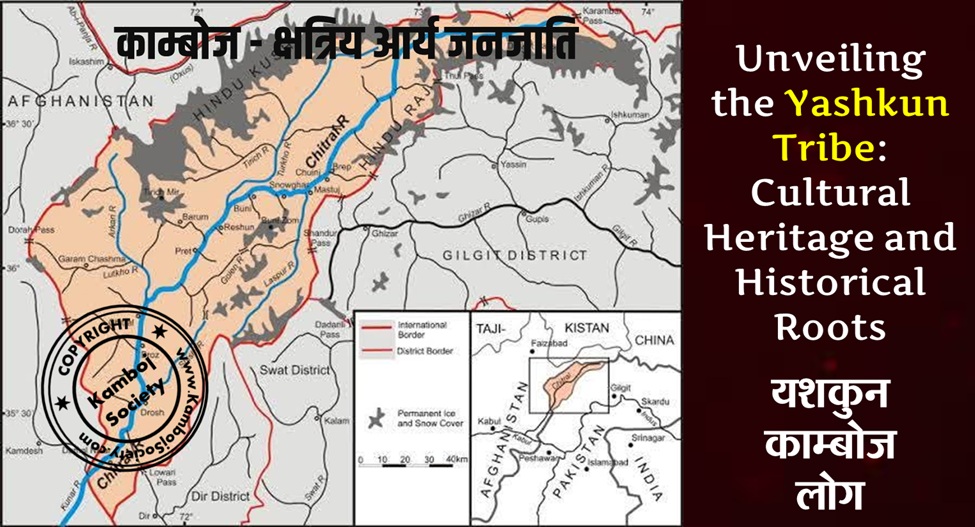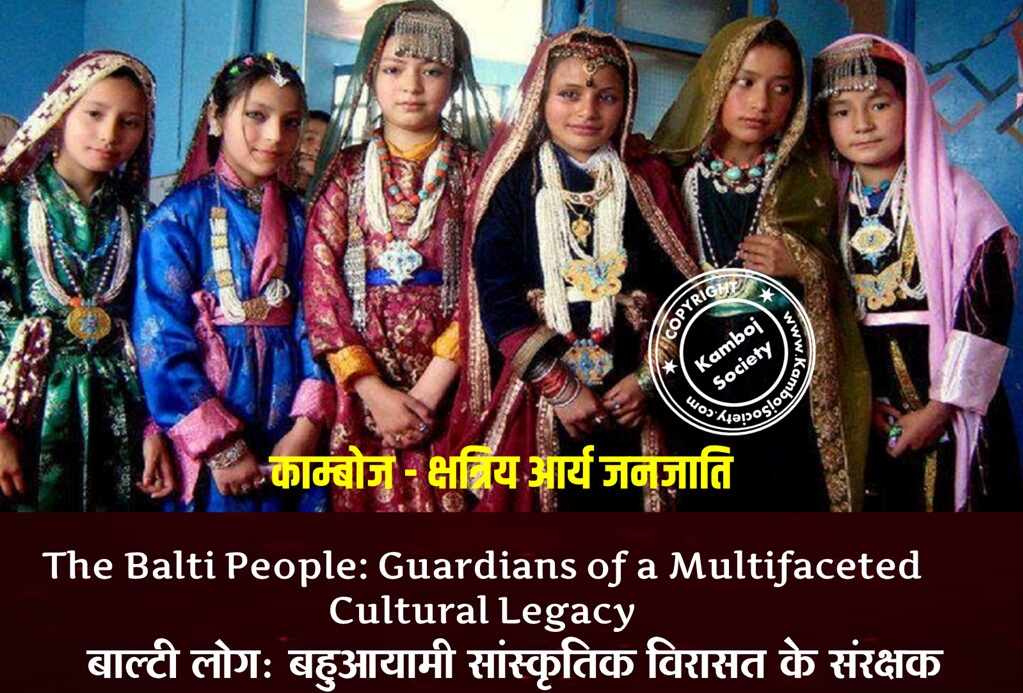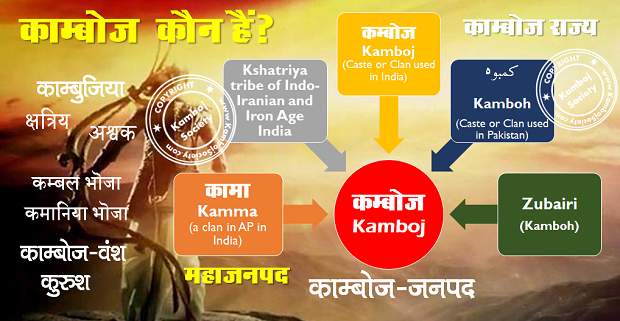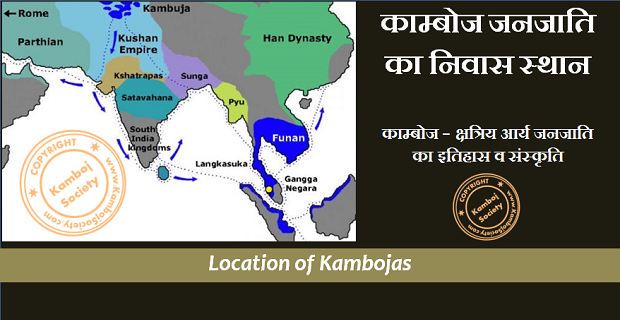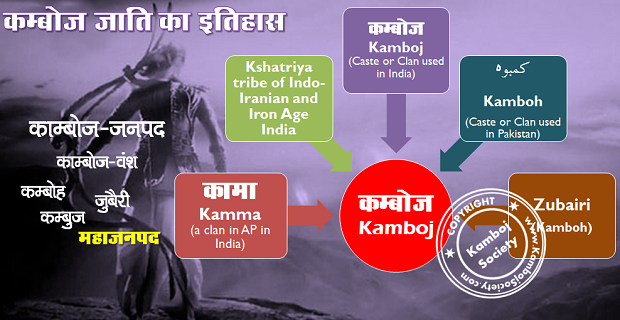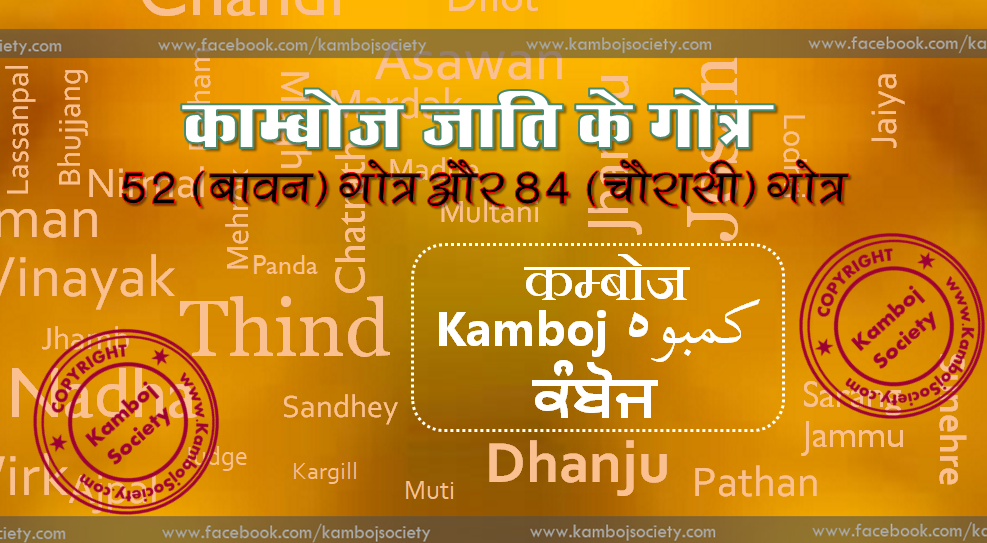Kambohs are said to be the modern representatives of ancient Kambojas. They are found as Hindus, Sikhs, Muslims, Persians, Jaina and Buddhists and are mostly confined to northern parts of India, Pakistan and eastern Afghanistan. The original home of the Kambojas was Pamir, Badakshan and northern parts of Tajikstan as far as Zeravshan in Central Asia. From time to time they are known to have entered South Asia and got assimilated into the local population. They have been followers of Zoroastrism, Brahmanism, Buddhism and Jainism in ancient times. With the advent of Islam in 5th/6th century AD and its later introduction into India, a section of Kamboj population switched to Islam. When the Muslim rule was established in India, the Kamboj people, like rest of the Indians, were also influenced by the new faith. The Ghaznavids period was marked by arrival in Punjab of the important spiritual figures like Hazrat Shaikh Ismail and Hazrat Ali Bin Osman popularly known as Data Ganj Baksh. They were successful in converting few of the Kamboj population to Islam (Tarikh-i-Sindh, by Ijazul Haq Quddusi). But the great pioneers of 13th century of the Sufi movement in South Asia were four friends known as Chahar Yaar, viz: (1) Hazrat Fariduddin Masud Ganj Shakar of Pak Pattan (1174-1266), (2) Hazrat Sayed Jalaluddin Bukhari of Uch-Bahawalpur (1196-1294), (3) Hazrat Bahauddin Zakaria of Multan (1170-1267) and (4) Hazrat Lal Shahbaz Qalandar of Sehwan (1177-1274). With their kind efforts, major sections of the numerous clans of Punjab like the Jats, Kamboj, Kharals, Tobians etc had embraced Islam. It is also notable that it were these Kamboj converts to Islam who had, for the convenience of the tongue, transformed the usual ancient Sanskrit and Persian word Kamboj into its current form Kamboh.
These Muslim Kamboj had interacted very favorably with the Lodhi, Pashtun and the Mughal rulers of India and through their hard work and personal abilities, many of them rose to great heights in civil and the military fields and became an important part of the ruling elite while others shone in the field of education and scholarship. Besides Muslim Kamboj, the Hindu Kamboj are also known to have contributed their share in the Mughal administration and management.
Muslim Kambohs (Kambojs) became especially influential and powerful during Mughal rule. General Shahbaz Khan Kamboh was the most trusted general of Akbar. [1] Shaikh Gadai Kamboh was the Sadar-i-Jahan in Akbar's reign. [2] Numerous other Kamboj are known to have occupied very key civil and military positions through out the Mughal reign.
"The Sayyids and the Kambohs among the Indian Muslims were specially favored for high military and civil positions during Mughal rule". [3] [4]
"The Indian Muslims, popularly known as Shaikhzadas, belonged largely to certain important clans like the Saiyids of Barha and the Kambohs" [5]
A. L. Basham writes: "The administrative reforms of Akbar changed the structure of even the Muslim leadership. The state was no longer the monopoly of the Mughals, or even the Iranis; the Afghans, and Indian Muslims such as Shaikhzadas, Saiyids, and Kambohs shared in its management. The hereditary status of a new entrant was an important consideration in assigning his first mansab, but promotion depended mainly upon talents and loyalty" [6].
Abu-Al-Fazal Alami, a prominent historian of the Akbar period, writes that it was a matter of honor to belong to the Kamboh lineage during the reigns of Mughal emperors Akbar and Jahangir and that no Kamboh was in economically bad circumstances in whole of India [7]
Saiyid Waris Shah had to say: "Although the rule of machines has depleted our feelings for one another, yet the Kamboh as a nation to this day is filled with passion" [8]
The Kambohs or Kambojs were classed among the ruling elites during the Muslim rule. [9]
The Moslem rule was a golden period for the Indian Kambojs [10].
There are numerous notable names of Muslim Kamboj in Indian history which can be mentioned here but more important of them are listed below and described for the knowledge of general readers.
- History
- Kamboj in Muslim Age
- Muslim Kambohs
- Hazrat Shaikh Alamsayakh Makhdoom Samayuddin Kamboh
- Hazrat Shaikh Abdullah Biyabani Kamboh
- Shaikh Nasiruddin Delhvi
- Shaikh Is-haaq Kamboh
- Shaikh Yahya Khan Kamboh
- Shaikh Abdul Gafoor alias Ladan Khan
- Mufti Jamal Khan Kamboh
- Shaikh Fateh Allah
- Nawab General Abu Muhammad Khan
- Nawab Saddullah Khan Chinioti
- Shaikh Jamali Kamboh
- Shaikh Abdul Gadai Kamboh
- Shaikh Bahawuddin Kamboh
- King Yusuf Chak
- Shaikh Abdul Aziz Kamboh
- Shaikh Abdulhaie Hyati
- Khan Jahan Amad-ul-Malik
- Shaikh Itmad-ul-Malik Sambhal
- Maulana Jaman Khan
- Shaikh Khawaja Hasan Multani Kamboh
- General Shaikh Hasham Khan Kamboh
- Nawab General Amadul Malik Kamboh
- Muhammad Akram Khan Kamboh
- Shaikh Sharif Khan
- Muhammad Husain Kamboh
- Mufti Mabu-al-Barkat
- Nawab Dadan Khan
- Shaikh Lali Kamboh
- General Karam Allah
- General Ilham Allah
- General Ranbaz Khan
- General Zainuddin Kamboh
- Shaikh Abdul Moman Kamboh
- Abu Muhammad Multani
- Nawab Bahadhur Khan Meeruti
- Muhammad Saleh Kamboh Lahori
- Shaikh Inayat-Allah Kamboh
- Nawab Mohabbat Khan Kamboh
- Mian Ahmed Khan Ban Bhabal Ban Jamal
- Khawaja Hasan Kamboh
- Muhammad Khan Kamboh
- Shaikh Abdul Jalil and Shaikh Ali Ahmed
- Nawab General Kheir Andesh Khan (Meerut)
- Nawab General Kheir Andesh Khan Sani
- Nawab General Kharyat Andesh Khan
- General Afit Andesh Khan Kamboh
- Nawab Suvab Andesh Khan
- General Hakim Al-mulak Imamuddin Khan
- General Ramzan Ali
- General Hakim Ghulam Ali Khan
- Hakim Salamat Ali
- Hakim Hazur Ali
- Hakim Abu Ali Khan
- Amjad Ali Khan
- Hamad Ali Khan
- Aga Ali Khan and Altaf Hussain
- Hakim Anayat Hussain Mahravi alias Inayat Husain b. Fath Allah
- Hakim Dayam Khan and Hakim Hazulr Ali Khan
- Shaikh Tajjuddin Kamboh
- Nawab Farhat Andesh Khan
- Mubarak Ali Khan
- Ahmed Allah Khan
- Asadaulla Khan
- Islam allah Khan
- Saif Allah Khan
- Suvab Andesh Khan
- Haji Mumtaz Ali
- Muhammad Sadiq
- Muhammad Ruh Allah
- Hafaz Zahur Alslam, Muhammad Sahib Ali Khan, and Gaziuddin Hussain Khan
- Amam-ud-din
- Maulvi Mazhar Allah
- Altaf Ali Khan
- Izhar Hussain Kamboh
- Muzaffar Hussain Kamboh
- Subhan Ali Khan Kamboh
- Ghulam Husain Kamboh
- Nawab Waqarul Mulk Maulvi Mushtaq Hussain (Kamboh)
- Nawab Dr. Sir Ziauddin Ahmad
- Nawab Sir Muhammad Yamin Khan
- Maulvi Bashiruddin
- Babu Maula Bakhash Kamboh
- Hindu/Sikh Kamboj
- Muslim Kambohs
Kamboj in Muslim Age
Muslim Kambohs
Hazrat Shaikh Alamsayakh Makhdoom Samayuddin Kamboh
Hazrat Shaikh Alamsayakh Makhdoom Samayuddin Kamboh was born in 1405 AD in Multan, now in Pakistan. His father Maulana Shaikh Fakhrudin was a venerable religious leader of that period. Makhdoom Shaikh Samayuddin was the royal spiritual adviser or Pir, first to emperor Behlol Lodhi, and later to Sikandar Lodhi. He commanded greatest respect amongst the entire Muslim spiritual and religious leaders of his time. The Mazar of Hazrat Shaikh Samayuddin is located in Delhi where the Zubairies of Panipat used to assemble every year for offering Fateha in pre-independence days.
Hazrat Shaikh Abdullah Biyabani Kamboh
Hazrat Shaikh Abdullah Biyabani Kamboh was the son of Hazrat Shaikh Alamsayakh Makhdoom Samayuddin Kamboh. For some reason, he got disillusioned with the emperor of Delhi and retired to a life of seclusion. For eighty summers and eighty winters of his life, Shaikh Biyabani lived in seclusion, in the forests among the wild and ferocious animals, doing the bandagi of Allah. All these years he fed himself only on roots, fruits and leaves of the forest trees. He was dedicated Nimajee and performed five Nimaz (Salat) a day, without exception, and also did one complete reading of the holy Quran every day, but never without having taken showers. He lived over a hundred years of age. It is also stated that he got endowed with some supernatural powers.
Shaikh Nasiruddin Delhvi
Shaikh Nasiruddin Delhvi was second son of Hazrat Shaikh Alamsayakh Makhdoom Samayuddin Kamboh, he was a teacher, educationist and a distinguished scholar of the Shariyat. He occupied the office of Shaikh-ul-Aslam from the times of Sikandar Lodhi till Mughal emperor Babar.
Shaikh Is-haaq Kamboh
Shaikh Is-haaq Kamboh was brother of Hazrat Shaikh Alamsayakh Makhdoom Samayuddin Kamboh. Shaikh Is-haaq was Malak-Alamsayakh v Alhalama according to the evidence furnished by Shaikh Jamali. He was a great scholar of Islam and of Asgar-i-Mahrfat.
Shaikh Yahya Khan Kamboh
Shaikh Yahya Khan Kamboh was bestowed the ruler ship of Aligarh by the Delhi emperor which stayed with his descendants for long time. One of his descendants, Muhammad Sayeed Khan, a Jagirdar of Kol (Aligarh), held a high rank in the army under Shah Jahan. His son Muzzahar Khan remained deputy-governor of Kashmir and Agra. Many of his descendants also occupied very high civil and military ranks during the Mughal rule.
Shaikh Abdul Gafoor alias Ladan Khan
Shaikh Abdul Gafoor was son of Shaikh Nasirudin Kamboh. A renowned scholar and philosopher himself, numerous of his students also turned out to be great scholars and educationists.
Mufti Jamal Khan Kamboh
Mufti Jamal Khan Kamboh was second son of Shaikh Nasiruddin and brother of Shaikh Abdul Gafoor. He remained Mufti (Judge) of Delhi during the reigns of Sikandar Lodhi, Babur, Humayun and Sher Shah Suri and died in 1582 AD at the age of 90. He used to deliver Khutabas and never paid visits to the emperor or the nobles. Rather, he always kept company with the respectable magistrates, scholars and intellectuals. Numerous of his students also became great intellectuals and scholars (Muntakhabhu-I-Tawarikh, Al-Badaoni, Ed Wolseley Haig, Vol III, 1973, p 123-24)
Shaikh Fateh Allah
Shaikh Fateh Allah was also a noted scholar and was greatly respected by the emperors from Sikandar Lodhi through Sher Shah Suri and the other high-ranking officers, courtiers and nobles. He was the son of Shaikh Nasiruddin and grand son of respected Hazrat Shaikh Alamsayakh Makhdoom Samayuddin Kamboh.
Nawab General Abu Muhammad Khan
Nawab General Abu Muhammad Khan grandson of Shaikh Abdul Gafoor. He was an influential courtier of Mughal emperor Shah Jahan and later of Aurangzeb. He held a mansab of 1400 and had conquered Hoogly Bandar for the Crown. He constructed one fort in Meerut which is still called after his name. He also established one village called Abu Muhammad Pur after his name. Besides, he also raised many works of public utility including the water pools, inns, mosques and irrigation canals.
Nawab Saddullah Khan Chinioti
Nawab Saddullah Khan Chinioti was the prime minister of Mughal emperor Shah Jahan. He had executed his office duties with great skill and responsibility.
Shaikh Jamali Kamboh
Shaikh Jamali Kambohwas also known as Shaikh Hamid bin Fazlullah, Dervish Jamali Kamboh Dehlwi or Jalal Khan. Jamali came from a Sunni merchant family of Kamboh lineage but was initiated into Sufism by the respected teacher Hazrat Shaikh Samayuddin Kamboh. Jamali was a noted Sufi of the Suhrawardiyya sect who died in AD 1536 while accompanying the Mughal Emperor Humayun in the latter's expedition to Gujarat. He was married to the daughter of Hazrat Shaikh Samayuddin Kamboh and was the tutor of Sultan Sikandar Lodi. He lived at Mehrauli during the reign of Sultan Sikandar Lodi and later composed panegyrics to the first of the Mughal emperor, Babur and his successor Humayun. A great poet of Persian language, Jamali wrote Siyar-l-Arifin (completed between AD 1530 and 1536) in Persian which is an account of the Chishti and Suhrawardi Sufis of the period. Shaikh Jamai died in 1536 AD and his tomb and a mosque known as Jamali-Kamali is situated near the Qutab Minar opposite the Ahinsa Sthal on Mehrauli's bypass.
Shaikh Abdul Gadai Kamboh
Shaikh Gadai Kamboh was the son of Shaikh Jamali Kamboh. After the second defeat during the 'exile at Gujarat', Shaikh Gadai paid a visit to Khan-Khanan and through his influence was appointed the Sadar-i-Sadur or Sadar-i-Jahan (Administrator General) of Akbar in 1563 AD which office he held till death in 1574 AD. The office of 'Sadar-i-Jahan' had been very important before the times of Mughals and even during Akbar's reign, he ranked as the third or fourth most powerful officer in the empire. It was his legal edict which legalized the accession of a new king. By the time of Akbar, the office had however, become corrupt especially so in the administration of grants & pensions and hence after assuming the office, the first thing Shaikh Gadai did was to draw the pen of obliteration through the grants and pensions of old servants of the crown so as to end the corruption ( Glossary of Tribes, p 499, H. A. Rose). Numerous old grantees and pensionees were affected by this action including probably chronicler Al-Badaonmi also and this seems to have earned the wrath of the latter. Al-Badaonmi, accordingly, makes very vitriolic and personal attacks on Shaikh Gadai, apparently annoyed of this drastic action. Emperor Akbar however, had a great respect for Shaikh. Everyone in the Darbar-a-Akbari was required to bow his head and shake his beard to pay obeisance to emperor as he entered the court, but Shaikh Gadai Kamboh was an exception. Rather, the emperor himself would come to the Shaikh to seek his blessings. Shaikh Gadai Kamboh wielded immense powers in the matters of general administration. He had unlimited powers to grant & take back the fiefs and pass on or remit death sentences. He was the highest law officer and it was his legal edict which legalized the accession of the king. He had undertaken numerous reforms including the land reforms during his office tenure. Al-Badaoni, the author of Muntakhbu-a-Twarikh, also writes that Shaikh Gadai Kamboh had obtained the position of Sadar-a-Sadur. In the religious matters, for many years Shaikh Gadai remained a very influential figure among the Pirs and great religious leaders of India, Khorasan, Iran and the Central Asian countries lying beyond the Oxus. He was a born poet and had written numerous poetry in Persian language in a traditional style which he used to sing in scholarly gatherings about which he was always very enthusiastic. The Khan-Khanan and Akbar himself attended these singing parties (Mehfils) at Shaikh Gadai's palace which Al-Badaoni however, depreciates in severe terms. Shaikh Gadai would regularly visit the Dargahs of Saints, Pirs & religious philosophers and would arrange annual fairs on their ursa. Shaikh breathed his last in 976 Hijri (1574/75). [11]
Shaikh Bahawuddin Kamboh
Not much is known about Bahawuddin Kamboh. He was however an important person in Darbar-i-Akbari since emperor Akbar had deputed him as his embassy to Yusuf Chak , the king of Kashmir, to persuade or force the latter to come to an understanding with Akbar.
King Yusuf Chak
Chak is a well known clan among the modern Kamboj. The Chaks of Kashmir are not its original inhabitants but are known to have migrated there from Daradistan. Since in ancient times, the Daradas and Kambojas were next door neighbors in the cis-Hindukush region,[12] it is very likely that Yusuf Chak, the ruler of Kashmir and his dynasty, could be traceable to ancient clan of the Kambojas living as neighbors to the Daradas in/around Kashmir. It is a known fact of history that ancient Kambojas had ruled over Kashmir during and prior to epic times[13]. So, it is very possible that the Chaks of Kashmir may not be of Daradic origin but rather may have come from Kamboja background
Shaikh Abdul Aziz Kamboh
According to Muslim historian Wahabuddin Kamboh, Shaikh Abdul Aziz was Prime Minister of emperor Ibrahim Lodhi [14]. But Chaudhry Muhammad Yusuf Hasan advises further research to confirm that Abdul Aziz indeed held the office of Prime Ministership (Tarikh-i-Quam Kamboh, p 309). Historian H. S. Thind, S Kirpal Singh and other scholars write that Abdul Aziz held the office of Prime Minishtership under emperor Ibrahim Lodhi.
Shaikh Abdulhaie Hyati
He was younger son of Shaikh Jamali and brother of Shaikh Gadai Kamboh. He was the Musahib of emperor Salim Shah Suri (1550-1560 AD) which fact is also confirmed by Al-Badaoni. Shaikh Hyati had very good relations both with Salim Shah Suri as well as his father Sher Shah Suri. Shaikh Hyati was a pastmaster in the arts of reciting latifas (titbits) and also wrote many Qasidas in praise of the emperor. He is best known for his hospitality and always played a host to students, poets and qulandaras from Iran, Turan and other trans-Oxian countries who visited Delhi in India. He died at the young age of 36.
Khan Jahan Amad-ul-Malik
He was Mir Adal (Judge) of emperor Sikandar Lodhi.
Shaikh Itmad-ul-Malik Sambhal
In the struggle between Humayun and Sher Shah Suri, Shaikh Itmad-ul-Malik had sided with the latter and supported him with all his resources. Shaikh Itmad-ul-Malik had lost his brother in the battle and later when Sher Suri ascended the throne of Delhi, he appointed Shaikh Itmad-ul-Malik as his Mashir but soon promoted him to Prime Minister. Sher Shah Suri and Shaikh Itmad-ul-Malik are both responsible for the rehabilitation/constriction of the Grand Trunk Road running between Peshawar and Calcutta. The duo is also responsible for the construction of numerous wells, water pools, hospitals and inns for the benefit of the general public. The well-to-do Muslim Kambohj families of Sambhal trace their lineage from Shaikh Itmad-ul-Malik. He died at Sambhal and his tomb is still located there (Silsila Aliya, Anayat Hussain Mahravi & Tarikh-i-quam Kamboh, Muhammad Yusuf Hasan, p 309).
Maulana Jaman Khan
He was the Hajab of emperor Sikandar Lodhi whom he had accompanied during his campaign of Awgantar. The fort was reduced fort in 1511 AD and emperor Sikandar appointed General Mujahid Khan as in charge of the fort. But later a conspiracy came to light which involved both general Mujahid Khan and Maulana Jaman Kamboh. Both were arrested on orders of the emperor and the charge of the fort handed over to Tajuddin Kamboh.
Shaikh Khawaja Hasan Multani Kamboh
He originally belonged to Multan (in Pakistan) but had moved to Marehra during reign of Sikandar Lodhi. Soon he drew the attention of the emperor and impressed him greatly with his abilities and competence. The emperor made Khawaja the ruler of Marehra. Muhammad Khan, the grandson of Khawaja Hasan was married to the daughter of general Shabaz Khan Kamboh, an illustrious General of emperor Akbar.
General Shaikh Hasham Khan Kamboh
Shaikh Hasham Khan was the grandson of Hazrat Shaikh Makhdoom Samayuddin. He held a mansab of 2500 during reign of Mughal emperor Jahangir.
Nawab General Amadul Malik Kamboh
Amadul Malik was grandson of Shaikh Hasham Khan Kamboh. In the later years of Aurangzeb, he was the chief judge of Lahore. During Bahadhur Shah's reign, Amadul Malik was appointed the governor of Multan. Nawab Amadul Malik held a mansab of 5000 person.
Muhammad Akram Khan Kamboh
Was the chief justice of Delhi during the reign of emperor Aurangzeb.
Shaikh Sharif Khan
He was a senior minister in the reign of Mughal emperor Aurangzeb (History of Lahore).
Muhammad Husain Kamboh
He was a high ranking officer in the reign of Mughal Emperor Aurangzeb.
Mufti Mabu-al-Barkat
He came from the lineage of Shaikh Hasham Khan Kamboh. Was Judge of Delhi.
Nawab Dadan Khan
He was from Kamboh family of Meerut. He remained Governor of Lahore for some time.
Shaikh Lali Kamboh
Was one of the famous nobles of Meerut. He was the author of Lala Bazar of Meerut.
Shaikh Abdul Moman Kamboh
Shaikh Abdul Moman Kamboh a noble from Sambhal. He held the office of Dewan-e-tan (Accountant General) under Shah Jahan. He performed the duties of granting and taking back the grants and pensions and promoting or demoting the officers of the Crown. Two of his sons also held the offices of Dewan-e-tan and Dewan-e-Khals under Nawab Sadddula Khan Chanyoti (Kamboh). The Muslim nobles of Meerut trace their lineage to Dewan-e-tan Shaikh Abdul Moman Kamboh (Tarikh-i-Qaum Kamboh, 1996, pp 313-314). Nawab Vakar Almalik Maulvi Mushtaq Hussain (Kamboh), a well-known Muslim leader of pre-independence days, the founding father of Muslim League was also from the lineage of Shaikh Abdul Moman Kamboh.
Abu Muhammad Multani
Was son of Shaikh Amad Multani. He was Amir Vizier in the court of Shah Jahan.
Nawab Bahadhur Khan Meeruti
Was also an Amir Vizier in the court of Shah Jahan.
Muhammad Saleh Kamboh Lahori
Was official biographer of the Emperor Shah Jahan and the teacher of Mughal Emperor Aurangzeb. Little is known of the life of Muhammad Saleh Kamboh Lahori other than the works he composed. He is stated to be younger brother of Inayat-Allah Kamboh and worked as Shahi Dewan with Governor of Lahore. Muhammad Salih is best remembered for his work Amal-i Salih, also referred to as Shah Jahan Namah (The History of Shah Jahan), which work he completed in 1659-60 AD. Amal-i-Salih is an account of the life and reign of Shah Jahan. However, the work also includes information on Shah Jahan's predecessors (particularly Akbar and Jahangir) and a compendium of biographies of the Shaikhs, poets, and other notables who were contemporaries with Shah Jahan. Muhammad Saleh Kamboh died in 1674 AD.
Shaikh Inayat-Allah Kamboh
(1608-1671): Shaikh Inayat was a historian. He spent his early life in the service of the Mughals and was a Mir Munshi (General) of Shah Jahan, but later retired from the world and lived as a recluse beside a shrine in Delhi. Inayat-Allah Kamboh wrote several historical works, but it was his collection of tales entitled Bahar-i-Danish (completed in 1651 AD), one of the most popular textbooks of Persian, which had brought him the most fame. He died in 1671 AD at Delhi. Historian Muhammad Saleh Kamboh, younger brother of Inayat-Allah Kamboh, has praised Bahar-i-Danish(Springtime of Knowledge) as a model of sophisticated workmanship (See: Muhammad Saleh Kamboh, Vol. 2, 1660: 862). It became part of the syllabi of the Persian schools because it is mentioned in a manuscript-copy of Khulasatul Makatib, written in 1688. Thus it was used in all the Persian schools, and by all educated men and women, both Muslims and Hindus, were acquainted with it in Mughal India. During British rule too, according to the education reports, it was taught in nearly all the schools and its style and idiom were regarded as the best models of composition (Reid 1852: 54)[17]. Bahar-i Danis is a "collection of romantic and lascivious tales dealing with the tricks employed by faithless wives to deceive their doting husbands", freely adapted from an earlier Indian source Shuka-Saptati into Persian. His another important work is Takmilah-yi-Akbar-Namah which is a continuation of Abu-al-Fazl's Akbar-Namah as Kamboh narrates the last four years of emperor Akbar's reign.
Nawab Mohabbat Khan Kamboh
Nawab Mohabbat Khan was governor of Peshawar and was the grandson of Nawab Dadan Khan, who remained for some time the governor of Lahore.
Mian Ahmed Khan Ban Bhabal Ban Jamal
Mian Jamal belonged to Jahangir's era. He was a noted scholar of Persian and Arabic languages. Tarikh Khan Jani v Makhzan Afgfhani addresses him as Fazal-i-Rozgar Janab Mian Ahmed Kamboh Dehlvi (p 516). Around 1614 A.D, Jamal wrote a famous book called Madan-e Akhbar-e Ahmadi in Persian language. The author of Makhzan Afghani pays very glowing tributes to his book. The original draft of the book is said to lie at British Museum London.
Khawaja Hasan Kamboh
Khawaja Hasan originally belonged to Multan but moved to Marehra (UP) where he was conferred a big fief and the rulership of Marehra by Pathan emperor Sher Shah Suri. (Ref: Kamboj Itihaas, (Draft), Roshan Din, Nizampur, p 225).
Muhammad Khan Kamboh
He was grandson of Khawaja Hasan and was the ruler of Marehra during Akbar's reign. He was the son-in-law of famous general of Akbar, Nawab Shahbaz Khan Kamboh.
Shaikh Abdul Jalil and Shaikh Ali Ahmed
They both belonged to Multan (Pakistan). At the end of nineteenth century, they held the offices of Deputy Collectors in British rule.
Nawab General Kheir Andesh Khan (Meerut)
He was the son of Nawab Mohabbat Khan. After Dara Shikoh was assassinated, he joined Aurangzeb's administration. With competency and his loyalty to the Crown, he was given a mansab of 5000 and was also awarded the title of Kheir Andesh Khan. He was also given an award of 0.7 million Darham for his meritorious military service as Faujdar at Etawa. During Bahadhur Shah's reign, his mansab was upgraded to 6000 men.
Nawab General Kheir Andesh Khan Sani
Was from Meerut line of Muslim Kamboh. His earlier name was Muhammad Massih. He was the grandson of Kheir Andesh Khan. Under Aurangzeb, Kheir Andesh Khan held a mansab of 1000 which was soon upgraded to 3000. He was also conferred the title of Nek Andesh Khan. During reign of Bahadhur Shah, Kheir Andesh Khan held a Mansab of 5000 which was later upgraded to 6000 men. He was also conferred the title of Kheir Andesh Khan. Kheir Andesh Khan had constructed one fort called Kheir Nagar at Bareilly. He also constructed one Eid-gah and Mubark Mahil in Bareilly. The ruler of Bundhel Khand was also reduced by this general. One of his sons also got the title of Nek Andesh Khan and was also awarded a Jagir of several villages near Bareilly.
Nawab General Kharyat Andesh Khan
Was the second son of Nawab Kheir Andesh Khan. He held a mansab of 5000 men. He was the governor of Kashmir and had constructed the Nawab Bazar there. One of his brothers also got the title of Kheir Andesh Khan Salas during the reign of emperor Ahmed Shah Durani. Nawab Kharyat Andesh Khan also held the governorship of Kashmir.
General Afit Andesh Khan Kamboh
He was son of Kharyat Andesh Khan. In the final years of Mughal rule, he was the Faujdar of Etawa and held a mansab of 2000 men.
Nawab Suvab Andesh Khan
was another Kamboh noble during the last days of Mughal empire. His grandson Fateh Ali Khan rose to very prestigious position during British rule.
General Hakim Al-mulak Imamuddin Khan
He held a mansab of 1500 during emperor Bahadhur Shah Alam Sani's reign.
General Ramzan Ali
Was son of Hakim Al-mulak Imamuddin Khan. He also held a mansab of 1200 during emperor Bahadhur Shah Alam Sani.
General Hakim Ghulam Ali Khan
held a mansab of 1000 during emperor Muhammad Shah. He also got the title of Hussain Ali Khan.
Hakim Salamat Ali
was Royal Physician of emperor Bahadhur Shah Alam Sani. Was conferred the title of Hazakat Khan.
Hakim Hazur Ali
held a Jagir of seven village in Bijnor and Muradabad. He was Royal Physician of Nawab Asaf Aldaulla.
Hakim Abu Ali Khan
was an Alam Fazal (scholar). He was Kotwal at Banda (Uttar Pradesh), then Tehsildar and later became Advocate of Meerut.
Amjad Ali Khan
He was son of Hakim Abu Ali Khan. Was a Deputy Collector.
Hamad Ali Khan
He was son of Amjad Ali Khan. He did his Bar-at-Law from England in 1885 AD and was a famous Advocate of Meerut.
Aga Ali Khan and Altaf Hussain
Were sons of Hakim Al-mulak Imamuddin Khan. They both were conferred titles of Khan Bahadurs by British government. Were also honorary Magistrates of Kanpur (See: Kamboj Itihas (Draft), Roshan Din Nizampur, p 226).
Hakim Anayat Hussain Mahravi alias Inayat Husain b. Fath Allah
Hakim Anayat Hussain Mahravi was a good scholar and writer. Wrote many books including Silsilah-i-Aliyah, which treats of the history of the Muslim Kambohs i.e the Shaikh Kambohs. The book contains supplements from Faid Ahmad b. Dildar Ahmad (Meerut).
Hakim Dayam Khan and Hakim Hazulr Ali Khan
were nobles in the court of Nawab Asaf Aldaula of Oudh. Their descendants currently live an Bijnor and Muradabad in UP.
Shaikh Tajjuddin Kamboh
Shaikh Tajjuddin Kamboh of Muradabad was first Tehsildar and then retired as Deputy Collector.
Nawab Farhat Andesh Khan
He had participated in the 1819 British war against the Gurkhas and was honored by the British Government. He was appointed Revenue Officer and was awarded a large Jagir.
Mubarak Ali Khan
He was son of Nawab Farhat Andesh Khan. He was Deputy Collector and retired in 1857. Later, he was made Honorary Magistrate of Meerut .
Ahmed Allah Khan
He was son of Mubarak Ali Khan. He was Special Honorary Magistrate in 1877 and was conferred the title of Nawab by the English Government.
Asadaulla Khan
He was son of Ahmed Allah Khan. He was an honorary Magistrate and was conferred the titles of Khan Bahadur and later of Nawab, by Queen Victoria.
Islam allah Khan
He was brother Asadaulla Khan and son of Ahmed Alla Khan. He was the first Indian to occupy the position Deputy Superintendent of Police and was also conferred the title of Nawab by the English Government.
Saif Allah Khan
He was the second brother of Asadaulla Khan. He retired as Deputy Collector.
Suvab Andesh Khan
of Meerut was awarded a Jagir by British Government of India. He was a very much respected by the English.
Haji Mumtaz Ali
Haji Mumtaz Ali was son of Suvab Andesh Khan. He was a Ambassodar from Wajid Ali Shah the ruler of Oudh to the court of English Governor General of India. After English occupation of Etawa, he was appointed special Magistrate of Etawa.
Muhammad Sadiq
He was son of Aji Mumtaz Ali Khan. Was Deputy Magistrate and Engineer. He was also conferred the title of Khan Bahadhur by the English Government. Later he became Chief Engineer of Hydrabad State.
Muhammad Ruh Allah
was second son of Haji Mumtaz Ali. He was also the Magistrate of Etawa and was conferred the title of Khan Bahadhur by the British Government.
Hafaz Zahur Alslam, Muhammad Sahib Ali Khan, and Gaziuddin Hussain Khan
Hafaz Zahur Alslam, Muhammad Sahib Ali Khan, and Gaziuddin Hussain Khan from this family were other important persons who held the offices of Deputy Collectors in Uttar Pradesh.
Amam-ud-din
Amam-ud-din held a Jagir of several villages in UP. He was Deputy Collector of Muradabad.
Maulvi Mazhar Allah
Maulvi Mazhar Allah remained home Secretary of Nizam of State of Hydrabad.
Altaf Ali Khan
Altaf Ali Khan was a Jagirdar and well known noble from Bareilly. He belonged to the lineage of Nawab Kheir Andesh Khan Sani who held a 6000 mansab in the reign of Aurangzeb and later that of Bahadhur Shah. The annual income of his Jagir was over 80000 rupees in those days.
Izhar Hussain Kamboh
He was minister at the court of ruler of Oudh. Was knighted and ennobled (Indo Aryans, Contribution Towards The Elucidation of Their ancient and Mediaeval History, Vol II, 1969, p 188, fn, Rajendrar Lal Mitra)
Muzaffar Hussain Kamboh
He was also minister at the court of Oudh. Was also knighted and ennobled (Ibid, p 188, fn, Rajendrar Lal Mitra)
Subhan Ali Khan Kamboh
Subhan Ali Khan was the Deputy Viceregent of Ghaziuddin Hyder, the ruler of Lucknow. Mirza Ghalib received an invitation to a reception in audience by the ruler's viceregent and was received splendidly in Lucknow through the mediation of Subhan Ali Khan Kamboh.
Ghulam Husain Kamboh
He was a noted scholar and historian of eighteenth century. He is the author of a very useful book known as Tarikh-i-Banaras.
Nawab Waqarul Mulk Maulvi Mushtaq Hussain (Kamboh)
He was born in the Meerut in 24 March 1841 and came of lineage of Shaikh Abdul Momin Kamboh who held the office of Dewan-e-Tun in Shah Jahan's reign. Vaqar Mulk did his engineering from Engineering College Roorki. He served as a Law Secretary in the Government of Hyderabad Daccan for some time and then joined Revenue Department. Later he was appointed Governor of the newly established State "VRARANGLE" and with his untiring efforts, the state soon became very prosperous. Vaqar Mulk received the title of Nawab Intezar Jung from the Government of Hydrabad. Then he was appointed Revenue Secretary with the orders of Nizam of Daccan. He served as Secretary, Personal Secretary & Advisor to the Prime Minister Nawab Bashiral Daulla. On December 9, 1890, he was awarded the title of Nawab Waqarul Mulk. On October 1892, Nawab Waqarul Mulk joined M.A.O. college in Aligarh, Uttar Pradesh. In December 1906, the quartet Nawab Waqarul Mulk, Sir Agha Khan, Sir Shafi of Lahore and Nawab Salimullah Khan of Dhaka organised a Mohammdan Educational Conference in Calcutta and on the same occasion, they also launched a new party called All India Muslim League of which Nawab Waqarul Mulk became General Secretary. In 1907, he was appointed Honorary Secretary of M.A.O. College. In the same year he resigned from the Secretaryship of the All India Muslim League on health grounds. In 1908, the Government of India honored him with the title of Nawab. It was the magnetising personality of Nawab Waqarul Mulk which had induced Quaid-e-Azam to join the All India Muslim League which fact changed the history of Indian subcontinent. The welcome address given by Nawab Waqarul Mulk on the occasion is an important document for the Muslims. Due to bad health, Nawab Waqarul Mulk gave up the Secretaryship of Aligarh in 1912 and after a prolonged illness, he died on January 27, 1917.
Nawab Dr. Sir Ziauddin Ahmad
Was born in 1877 at Meerut in the renowned Zuberi (Kamboh) family of India. He obtained his M.A. with distinction in Mathematics in 1898 from Aligarh and D.Sc also with distinction from Allahabad University in 1901. His brilliant academic career won him the scholarship to join the Cambridge University, England in 1901 from where he took his mathematical Tripos topping the University and became a Wrangler. He obtained his Ph.D. degree in 1905 from Gottengen University in Germany. For further education Dr Ziauddin joined Peris University and later Bologna University Italy and then on return to India, he joined the alma mater as a Professor of Mathematics. It was due to his untiring efforts that a Medical and Engineering colleges were founded and the Aligarh Muslim College was converted to Aligarh Muslim University where Dr Ziauddin Ahmad worked as a Lecturer, Professor, Principle, Pro-Vice-Chancelor, Vice-Chancelor and Rector respectively. Dr Ziauddin Ahmad can be reckoned as next to Sir Syed Ahmad Khan in the spread of education among the Muslims who owe him a profound sense of gratitude. Dr Ziauddin played a dominant role in the renaissance of Muslim education in the sub-continent after Sir Syed Ahmad Khan and faithfully carried on the torch of education right to the rank and file of the Muslims throughout the sub-continent. As a very faithful successor of Sir Syed, he carried on the task of educating the people in the teeth of opposition when he proceeded to England to receive the coveted Sir Issac Newton Scholorship. In 1917 Dr. Ziauddin was also appointed member of the Calcutta University Commission of which Sir Michael Saddler was the President. Dr Ziauddin Ahmad rendered yeoman's services to the Muslims of the sub-continent, worked for their progress and welfare and devoted all his life to the eradication of ignorance and illiteracy. He became member of Legislative Assembly (MLA) of UP in 1991 and 1922. The second Muslim Kamboh Conference held at Marehra (District Etha U.P) on 21st & 22nd April 1935 in Marison Islamia School was presided over by Dr Ziauddin Ahmed. He was one of the earliest members of the All-India Muslim League and stuck to the organization till the end of his life. As desired by Quaid-e-Azam, Dr Ziauddin became Parliamentary Secretary of the Muslim League in the Central Assembly of India in 1938. Dr Ziaddun remained member (M.P.) of Central Assembly of India from 1930 till 1947. In 1946, he was the chief whip of the Muslim League in the Central Assembly. He was awarded the title of Sir by the Government of India. Dr Ziauddin did an outstanding job in Budget-making for the Indian Railways and later also worked with the Reserve Bank of India and he achieved the goals which the Indian National Congress had fought and lost. Dr Sir Ziauddin Ahmad was a trusted Lieutenant and Associate of the Muslim pioneers like Sir Syed Ahmad Khan, Nawab Waqarul Mulk Kamboh, Nawab Mohsinul Mulk, Sir Sultan Muhammad Khan Aga Khan 111, Syedna Tahir Saifuddin, Quaid-e-Azam and Quaid-e-Millat Liaquat Ali Khan. After partition, the family of Dr Sir Ziauddin moved to Pakistan. In August 1947, he was appointed advisor to Government of Pakistan by Quaid-e-Azam Mr Muhammad Ali Jinah. Dr Sir Ziauddin died on December 23, 1947 and in compliance of his wishes, his body was brought to India and buried within the campus of Aligarh Muslim University. Dr Sir Ziauddin Ahmad's daughter Dr Mrs Aijaz Fatima Tajammul, her husband Dr Tajammul Hussain, and Dr Asim Hussain have done a good job by establishing in Pakistan the important institutions viz: Dr Sir Ziauddin Memorial Hospital, Dr Sir Ziauddin Post-Graduate Medical Institute and Dr Sir Ziauddin Medical College all running under Dr Sir Ziauddin Ahmad University. This was an excellent step to perpetuate the memory of the great scholar and educationist of the Kamboj lineage. Dr Sir Ziaddun was the first Kamboj to have become a member of Indian Parliament (M.P.) and was also the first Kamboj to have been knighted as Sir [18].
Nawab Sir Muhammad Yamin Khan
He is another very important Kamboh hero of the pre-independence days. Bar-at-law by training, Muhammad Yamin Khan belonged to Meerut and was a prominent legal luminary, statesman, politician, parliamentarian and one of the senior most members of the All India Muslim League. British Government recognized him for his outstanding social and legal services and had knighted him by with the titles of Sir and Nawab. A close confidant of Quaid-e-Azam, Sir Yamin Khan was a member of the working committee of All India Muslim League. He also remained Deputy President of the Indian legislative council. Sir Muhammad Yamin Khan was also the President of the third Kamboh Conference held in Bareilly in 1936. His brother Chaudhry Muhammad Yamin Khan was also a highly educated person and a prominent Judge of pre-independence period. After partition, the family had moved to Karachi, Pakistan where Sir Muhammad Yamin Khan soon died. Sir Muhammad Yamin Khan was the second Kamboj member to be knighted as Sir and also was the second Kamboj member of the Indian Parliament (M.P.) [19].
Maulvi Bashiruddin
Maulvi Bashiruddin was a great educationist and scholar. He was a close relative of Dr Sir Ziauddin Ahmad. He founded and owned the news paper called Al-Bashir published from Etawah, and also founded The Islamic High School, Etawah. He was also the president of the first Muslim Kamboh Conference held at Meerut in December 1933.
Babu Maula Bakhash Kamboh
He joined the State of Malerkotla as a revenue officer, but was soon promoted and worked as Justice, Collector, Accountant General and Police Chief. Later he was also appointed Revenue Minister of the State. After partition and on the merger of Malerkotla into "Patiala and East Punjab States Union" (PEPSU), Babu Maula Bakhash was appointed its Administrator.
Hindu/Sikh Kamboj
Rai Bansi Das Kamboh
Bansi Das kamboh was minister in the jury of Darbar-i-Akbari and was very close to Nawab General Shahbaz Khan Kamboh. Amir Alamara Khan Zaman-i-Shaibani and his brother Bahadhur Khan-i-Shaibani who held mansabs of 5000 under Akbar rose in rebellion against the Crown which move was crushed by Akbar with the help of Shahbaz Khan. Khan Zaman-i-Shaibani was killed in the fight. General Bahadhur Khan-i-Shaibani was arrested and was handed over to Shahbaz Khan Kamboh and Rai Bansi Das Kamboh. According to Aina-i-Akbari of Abu-al-Fazal Alami, General Bahadhur Khan-i-Shaibani was executed by Shahbaz Khan Kamboh and Rai Bansi Das Kamboh in compliance of orders from emperor Akbar. But according to Tarikh-i-Farishta (Part I, p 710), General Bahadhur Khan-i-Shaibani, being considered a threat to the empire, was executed without waiting orders from the Emperor.
Raja Bhim Singh Kamboh
He was ruler of Sarkap located south of Patti on river Satluj (in district Amritsar). He was among the eight raja or rulers who were mobilised by Abadullah Samad Khan, the Mughal Governor of Punjab against Sikh warrior Banda Singh Bahadhur (Ref: Tarikh-I-Kambohan, Chaudhry Wahabuddin Kamboh; The Later Mughals, by William Irvin). However, according to historian S Kirpal Singh Dardi, Bhim Singh Kamboh was ruler of Sarkap located in Rawalpindi near Taxila.
The Kambohs
The Kambohs held Nakodar in Jullundur and Sohna in Gurgaon some centuries ago; and the tombs and mosques that they have left in Sohna show that they must have enjoyed considerable position [24].
References
- Glossary of Tribes and Castes of Punjab and north-West Frontier Province, Vol I, H. A. Rose; Aina-i-Akbari by Abu-L-Fazl Alami, Trans H. Blochman, p 122
- The composition of the Mughal nobility, Concise Encyclopedia Britannica, Online
- The Mughal Nobility Under Aurangzeb, 2002, p 21, M. Athar Ali
- The Mughal Nobility Under Aurangzeb, p 21, M. Athar Ali
- Cultural History of India , July, 1999 - Oxford University Press, USA, p 261, A. L. Basham
- Aina-i-Akbari, Abu-al-Fazal, English Trans by H. Blochman, Part I, pp 436
- Sayed Waris Shah
- Kamboj Chetna Manch, 1993, Dr. (Prof) Jaspaul K Dhanju
- These Kamboj People, 1979, p 196, K. S. Dardi.
- Muntakhbu-a-Twarikh, Trans W. H. Lowe, II, pp 22, 124; Maasiru-ul-Umara, II, pp 540-41.
-
- DaradansahaKambojairajayatpakashasanih ||
- (verse from Mahabharat 2.27.22)
- ete desha udichyastu
- Kambojashchaiva Dardashchaiva Barbarashcha Angaukikah ||
- Chinashchaiva Tusharashcha Pahlavadhayata narah ||
- ................................................................................
- (Extracts from Kirfel's Text of Bhuvanakosha countries)
- Karana Rajapuram gatva Kamboja nirjita-stvaya, MBH VII.4.5 & MBH 7.91.39-40; See: Political History of Ancient India, 1996, p 132-135, Dr H. C. RayChaudhry. The Rajapura of MBH has been identified with Rajaori on the authority of Yuan Chawang
- Tarikh-i-Kambohan, Chauhdri Wahhab ud-din Kamboh Amritsari, Nurpur( Layalpur), p 202
- Aina-i-Akbari, Abu-al-Fazl Alami, Trans H. Blochman, 1965, Part I, p 347.
- Muslim Civilizatiuon in India, New York, Columbia University Press, 1964 , XII. Religion at Akbar's Court, S. M. Ikram, (Ed) Ainslie T. Embree.
- See: Language, Ideology and Power : Language-Learning among the Muslims of Pakistan and North India , p 127, Tariq Rahman (02 May, 2002) - Oxford University Press, USA
- Tarikh-i-Qaum Kamboh, 1996, p 347
- Tarikh-i-Qaum Kamboh, 1996, p 385
- Empire and Information : Intelligence Gathering and Social Communication in India, 1780-1870 (Cambridge Studies in Indian History and Society), Cambridge University Press 2000, p 285, C. A. Bayly, Rajnarayan Chandavarkar, Gordon Johnson, and C.A. Bayly; also: Language, Ideology and Power: Language-Learning among the Muslims of Pakistan and North India, 2002 - Oxford University Press, USA, p 126, Tariq Rahman.
- Aiana-i-Khemkaran, Lahore, 1925, p 283, S Partap Singh Nibber.
- Panth Parkash, 1970, p 531-532, Giani Gian Singh
- op cit, p 531, Giani Gian Singh.
- Glossary of Tribes and Castes of Punjab and north-West Frontier Province, Vol II, pp 444-446, H. A. Rose; Punjab Castes, by Ibbeston, 1885, p 148
-
Books and Magazines
- A Cultural History of India, A. L. Basham
- Aina-i-Akbari by Abu Fazal Alami
- Tarikh-i-Qaum Kamboh, 1996, Chaudhry Muhammad Yusuf Hasan
- The Kambojas Through the Ages, 2005, S Kipal Singh
- Kamboj Itihas, 1972, H. S. Thind
- A Draft on Kamboj Itihaas, Roshan Din Nizampur (Pakistan)
- These Kamboj People, 1978, S Kirpal Singh
- Indo-Aryan, Contribution Towards the Elucidation of Their Ancient and Mediaeval History, 1969, Rajindraraja Mitra
- Silsila Aliya, Hakim Anayat Hussain Mahravi
- Muntakhabu-i-Tawarikh, Al-Badauni, Trans Wolseley
- Punjab Castes, 1970, Denzil Charles Ibbetson
- Glossary of Tribes and Castes of Punjab & N.W.F Province, H. A. Rose
- Tarikh-i-Kambohan (Urdu), 1917, Amritsar, Chaudhry Wahabuddin


